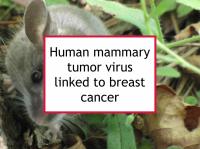Breast cancer risk appears to be derived from a combination of factors, including genetic susceptibility, exposure to carcinogens, diet, lifestyle factors, and harmful mutations. However, since some very young women with no obvious exposures to breast carcinogens or family history develop the disease, other factors must also influence risk.
After considerable skepticism, debate and study, infection with certain viruses has emerged as a breast cancer risk factor. Now a new study has reported that a virus originally transmitted to humans from mice and mutated thereafter may be responsible for some cases of breast cancer, including some of the most aggressive.
Latest research links HMTV to breast cancer
The study referenced at the beginning of this new article makes the case that HMTV can be a cause of breast cancer. HMTV has been found in approximately 40% of U.S. women's breast cancers, including in studies using techniques to rule out mouse DNA contamination.
Asian countries have lower rates of breast cancer (29 to 43 per 100,000 per year) than Western European countries and their former colonies (47 to 92 per 100,000 per year), a difference that could be explained in part by a lower rate of HMTV-related breast cancer in Asia. The Mus castaneus and Mus musculus found in Asia have lower rates of MMTV than the Mus domesticus found in the West.
HMTV has been found in the breast milk of approximately 8% of the general U.S. female population and 21% of women biopsied for breast cancer. HMTV obtained from metastatic breast cells has been shown to be capable of infecting human breast epithelial cells in the laboratory. When non-cancerous human breast epithelial cells are infected with HMTV, they undergo molecular changes associated with epithelial-mesenchymal transition (EMT).
EMT enables an epithelial cell to acquire enhanced migratory capacity and invasiveness, as well as increased resistance to apoptosis (programmed cell death). HMTV sequences are more prevalent in pregnancy-associated, familial and inflammatory breast cancer than in unselected non-familial samples, consistent with a link to more aggressive breast cancer types.
The authors have detected HMTV in 94% of primary cultures of metastatic breast cells obtained from effusion fluids, thereby establishing a direct connection between the presence of HMTV and metastatic breast cancer. In addition, HMTV found in primary breast tumors has also been found in their associated positive axillary lymph nodes. These results together suggest a link between HMTV and breast cancer aggressiveness.
The authors conclude that the study of HMTV represents a new avenue of breast cancer research involving epidemiology, etiology, molecular mechanisms, diagnosis, prevention and treatment.
